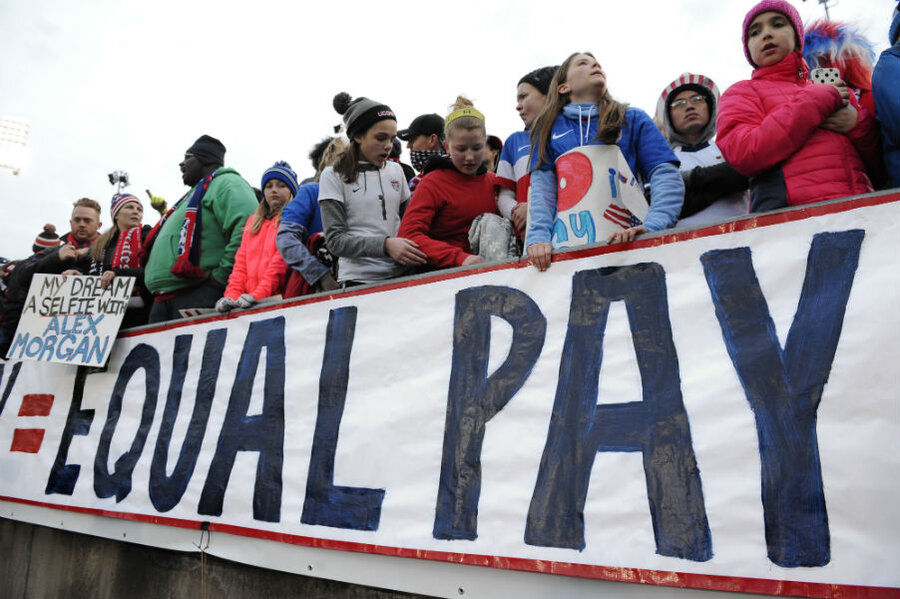How gender pay gap trickles into retirement savings
Many Americans struggle to save for retirement, but the gender wage gap makes the prospects for women even more dire: The average woman must save $1.25 for every $1 a man invests to build an equivalent nest egg, a new study shows.
For every $1 men earned in 2015, women, on average, made 80 cents, up from 77.5 cents in 2007, according to an analysis of the latest data available from the U.S. Census Bureau. While pay parity remains elusive, the gap is closing more in some states than in others, which translates into a smaller shortfall in retirement savings.
For example, in New York, the state with the narrowest wage gap, women must sock away $1.13 for every $1 a man puts in a 401(k), traditional individual retirement account, Roth IRA or other investment plan to reach the same amount. In Oklahoma — the state where women’s wages lost the most ground since 2007 — women would need to set aside $1.37 for every $1 a man saves to catch up, the analysis by NerdWallet found.
Both men and women struggle to save for retirement. The National Retirement Risk Index suggests roughly half of American families aren’t saving enough to maintain their standard of living once they’ve retired. But the wage gap can make the challenge more pronounced for women, who live, on average, five years longer than men.
So, what’s behind the wage gap? Research suggests the issue isn’t that a woman working a particular job makes less than her male colleague; rather, it’s that the odds are greater that he will rise to upper management and earn more.
As well, a 2014 Harvard study suggests women are far more likely to take career breaks for child and elder care, which limits the number of women working in more time-consuming jobs with little flexibility for family needs.
A checklist for saving for retirement
To help keep the wage gap from expanding into an even larger retirement shortfall, try these suggestions to maximize savings:
- Get the full match on your workplace retirement account. Employers often will match — up to a limited amount — the cash you contribute to a workplace retirement account, such as a 401(k) or 403(b). Your contributions are made pretax, directly from your paycheck.
- Set up a Roth or traditional IRA. IRAs also offer tax benefits to savers who qualify. If you are married and file taxes jointly, a non-working spouse can open and contribute to an IRA based on the working spouse’s income. A Roth IRA calculator can show you how much you can contribute.
- Use a taxable account. After maxing out tax-advantaged retirement savings accounts, you can invest further in the stock market’s long-term earning power. While there is always some degree of uncertainty when it comes to stocks, taking an appropriate risk can help the dollars you save work harder.
What’s the gap in your state?
Here are the states where women’s incomes average the most — or fewest — cents on the dollar compared with men, and where the pay gap saw the most — or least — improvement. If your state isn’t on one of these lists, you can find it here.
10 states with the smallest wage gaps in 2015
- New York (Women made 88.7 cents for each $1 men earned)
- Delaware (88.5 cents)
- Florida (86.6 cents)
- North Carolina (85.9 cents)
- Rhode Island (85.8 cents)
- California (85.7 cents)
- New Mexico (84.6 cents)
- Hawaii (84.1 cents)
- Vermont (83.8 cents)
- Nevada (83.7 cents)
10 states with the largest wage gaps in 2015
- Wyoming (Women made 64.4 cents for each $1 men earned)
- Louisiana (68 cents)
- West Virginia (70.6 cents)
- Utah (71.1 cents)
- North Dakota (71.1 cents)
- Montana (72.5 cents)
- Oklahoma (73.2 cents)
- Idaho (73.5 cents)
- Michigan (74.3 cents)
- Ohio (74.7 cents)
10 states where the wage gap improved the most, 2007-2015
- Rhode Island: (Wage gap shrunk 10.96%)
- Delaware: (10.19%)
- New Hampshire: (9.87%)
- Kentucky: (9.28%)
- Connecticut: (9.00%)
- Florida: (8.41%)
- Illinois: (7.96%)
- South Carolina: (7.83%)
- New York: (7.76%)
- New Mexico: (7.55%)
10 states where the wage gap improved the least, 2007-2015
- Oklahoma (Wage gap grew 5.57%)
- Utah (grew 1.35%)
- Vermont (grew 0.40%)
- Texas (no change)
- Idaho (Wage gap shrunk 0.45%)
- Ohio (shrunk 0.99%)
- Nebraska (shrunk 1.21%)
- Georgia (shrunk 1.28%)
- Virginia (shrunk 1.37%)
- Colorado (shrunk 1.37%)
Kevin Voigt is a staff writer at NerdWallet, a personal finance website. Email: kevin@nerdwallet.com. Twitter: @kevinvoigt. Jonathan Todd is a data analyst at NerdWallet. Email: jonathan.todd@nerdwallet.com.
This story originally appeared on NerdWallet.






